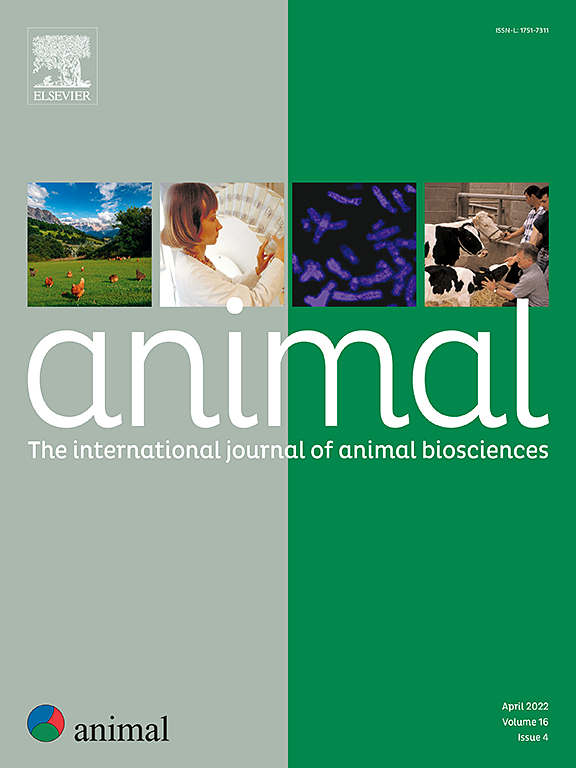Determinants of fertility in timed artificial insemination programs in beef cattle: predictive ability and risk factors from almost 2 million data points
IF 4
2区 农林科学
Q1 AGRICULTURE, DAIRY & ANIMAL SCIENCE
引用次数: 0
Abstract
Timed artificial insemination (TAI) is a technology widely used in cattle production based on controlling ovarian follicular growth. This study analyzed a large database aiming to determine the influence of several intrinsic and extrinsic female factors, as well as their interactions to determine risk factors and produce prediction ability in beef cattle. A total of 1 832 999 TAIs conducted on 2 002 farms across South American countries were considered for the analysis, including 15 main fixed effects or interactions in the statistical model, in addition to five random effects. The pregnancy/A.I. (P/AI) was affected by Order of service (1st TAI > resynchronizations), body condition class (BCS) (high > medium > low), female genetic group [Bos taurus and crossbreds > Bos indicus], breeding season (reduction of the P/AI every year), female category [Non-lactating multiparous > Suckled multiparous > Suckled primiparous > Nulliparous heifers], period of year (July-September, October-December and January-March > April-June) and climatic region as well as the interactions between Order of service and female category, BCS class and female genetic group (impact of BCS: Bos taurus or crossbreed animals > Bos indicus), BCS and female category (impact of BC:S Suckling > non-Suckling categories), female category and time of female availability, female category and female genetic group, female category and climatic region, and climatic region and period of the year. Farm, technician, and sire were the variables with the highest predictive ability for P/AI. At the same time, breeding season, climatic region, and time of female availability were the variables with the lowest predictive ability. In conclusion, the main female intrinsic factors that affected fertility in commercial beef cattle A.I. programs were the Order of service, BCS class, female category, and female genetic group. The female extrinsic factors that most affected P/AI were the breeding season and the climatic region. Farm, A.I. technician, sire, and the interaction between the female category and BCS class were the variables with the highest predictive abilities on pregnancy per TAI. Conjunctural factors, which are more adjustable, have a higher impact on P/AI prediction ability than structural factors. Thus, farm management and structure, A.I. technician, bull semen, and female BCS should be the main factors of attention to obtain good results in applying this biotechnology in beef cattle. Despite the influence of each factor, this study demonstrated the usefulness of analyzing big databases, allowing to determine effects that cannot be studied with experimental approaches, providing a complementary approach to decide where to focus future studies to enhance TAI pregnancy rates in beef cattle.
肉牛定时人工授精计划中生育力的决定因素:来自近200万个数据点的预测能力和风险因素。
定时人工授精(TAI)是一种以控制卵巢卵泡生长为基础,广泛应用于牛生产的技术。本研究分析了一个大型数据库,旨在确定几个内在和外在的雌性因素对肉牛的影响,以及它们之间的相互作用,从而确定危险因素并产生预测能力。在南美洲国家的2002个农场进行的总共1 832 999个TAIs被用于分析,包括统计模型中的15个主要固定效应或相互作用,以及5个随机效应。怀孕/人工智能(P/AI)受服役顺序(第1次TAI >再同步)、体质等级(BCS)(高>、中>、低>)、雌性遗传群(牛牛和杂交品种>)、繁殖季节(每年P/AI降低)、雌性类别(非泌乳多产>泌乳多产>泌乳初产>无产母牛)、季节(7 - 9月)、10 - 12月和1 - 3月(bbb4 - 6月)与气候区的相互作用,以及服务顺序与雌类、BCS类与雌遗传群(BCS: Bos taurus或杂交动物> Bos indicus的影响)、BCS与雌类(BCS: S哺乳类>非哺乳类的影响)、雌类与雌可利用时间、雌类与雌遗传群、雌类与气候区、气候区与季节的相互作用。农场、技术人员和品种是对P/AI预测能力最高的变量。同时,繁殖季节、气候区和雌虫可得期是预测能力最低的变量。综上所述,在商业肉牛人工智能程序中,影响生育力的主要雌性内在因素是服役顺序、BCS等级、雌性类别和雌性遗传群。对P/AI影响最大的雌性外部因子是繁殖季节和气候带。农场、人工智能技术人员、男性、女性类别和BCS类别之间的相互作用是对每TAI妊娠预测能力最高的变量。对P/AI预测能力影响较大的是可调性较强的行情因素,而不是结构性因素。因此,在肉牛中应用该技术,要取得良好的效果,应注意农场管理和结构、人工智能技术人员、公牛精液和雌性BCS。尽管每个因素都有影响,但本研究证明了分析大型数据库的有用性,可以确定无法通过实验方法研究的影响,并提供一种补充方法来决定未来研究的重点,以提高肉牛的TAI怀孕率。
本文章由计算机程序翻译,如有差异,请以英文原文为准。
求助全文
约1分钟内获得全文
求助全文
来源期刊

Animal
农林科学-奶制品与动物科学
CiteScore
7.50
自引率
2.80%
发文量
246
审稿时长
3 months
期刊介绍:
Editorial board
animal attracts the best research in animal biology and animal systems from across the spectrum of the agricultural, biomedical, and environmental sciences. It is the central element in an exciting collaboration between the British Society of Animal Science (BSAS), Institut National de la Recherche Agronomique (INRA) and the European Federation of Animal Science (EAAP) and represents a merging of three scientific journals: Animal Science; Animal Research; Reproduction, Nutrition, Development. animal publishes original cutting-edge research, ''hot'' topics and horizon-scanning reviews on animal-related aspects of the life sciences at the molecular, cellular, organ, whole animal and production system levels. The main subject areas include: breeding and genetics; nutrition; physiology and functional biology of systems; behaviour, health and welfare; farming systems, environmental impact and climate change; product quality, human health and well-being. Animal models and papers dealing with the integration of research between these topics and their impact on the environment and people are particularly welcome.
 求助内容:
求助内容: 应助结果提醒方式:
应助结果提醒方式:


